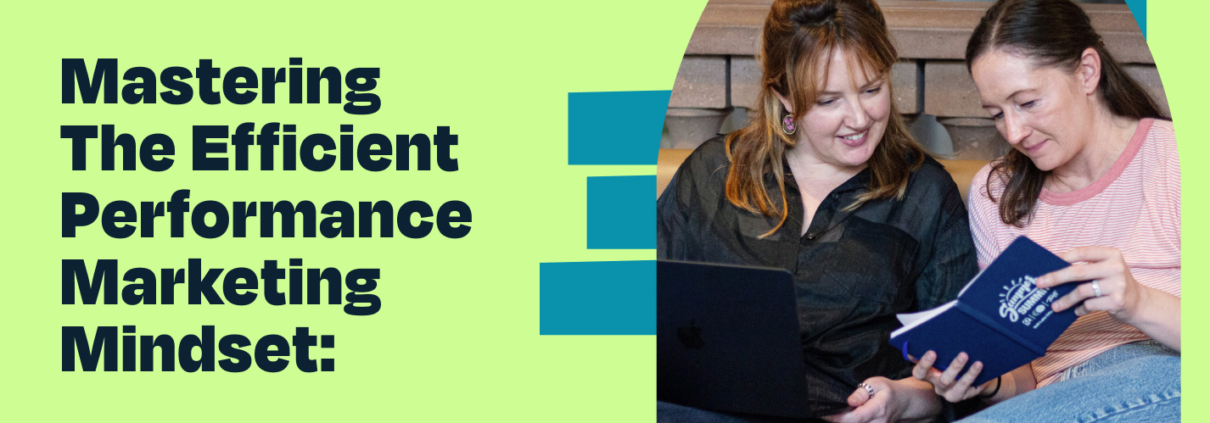Mastering the Efficient Performance Marketing Mindset: Unraveling the Justification for Marketing Investments in 2024
The prevailing theme of 2023 has been “Achieve More With Less.” This is especially true right now with uncertainty still at an all-time high and the competition greater than ever as we enter the second half of the year. Marketers find themselves in a tough position, having to compete for budgets, justify top-of-the-funnel initiatives and expenses, and, in the end, address questions from the CFO and board about last-click conversions and why they aren’t simply directing funds to search, given its superior CPA. The key to companies’ success this year, and beyond, has largely hinged on embracing an efficient performance marketing mindset.
If you find yourself facing a similar challenge of doing more with less, a situation we’re in daily with almost all of our clients at Tuff, I’d like to offer you three specific growth strategies that I’ve found effective at driving MoM growth, unlocking more marketing dollars, and ultimately ensuring alignment among stakeholders.
The beauty of these strategies lies in their familiarity, as many brands are already employing them in various ways. The challenge is refining how these efforts are communicated. Often, the “why” behind these performance marketing initiatives is not clearly conveyed to non-marketers or company stakeholders. To ensure transparency, accountability, and alignment among all parties involved, it’s crucial to communicate the rationale behind these strategies effectively. Justifying increased marketing investments becomes more feasible when everyone understands the purpose and potential benefits of these tactics and budget allocations.
In this post, I’ll dive into these strategies, emphasizing their significance and how you can harness support from core stakeholders. We’ll begin by examining how to ensure that no low-hanging fruit is overlooked, and we’ll explore how paid data can be utilized to inform an organic approach, which will ultimately help you minimize your reliance on paid channels.
Once you’ve successfully implemented those two strategies, I’ll elaborate on measuring top-of-the-funnel spend and the investment in these channels. The initial findings of the Reuters Events: State of Marketing survey revealed that the top brand priorities right now include enhancing brand identity, boosting brand awareness, and focusing on purpose and value-driven marketing. This indicates the necessity of maintaining investments in channels that may not provide immediate last-click conversions but play a crucial role in achieving these priorities. In order to do that, you need to measure the impact and validate the return on investment, even when you can’t see a last-click conversion in GA4 or your CRM.
Let’s jump in.
Strategy #1: Find your paid search threshold
Considering paid media and its diverse platforms, each one occupies a distinct stage in the customer journey. Some platforms boast substantial reach and efficiency, yet they reside higher up in the sales funnel and attract users with lower intent, lacking a buyer mindset. Conversely, platforms like search or retargeting strategies offer access to warmer audiences with stronger intent. While these avenues may not yield as much volume and the traffic tends to be pricier, but this audience is usually primed for purchase, leading to quicker and more efficient conversions.
When managing your media budget, you’re probably dividing funds among paid search, display, and social channels, considering a blended cost per lead (CPL) or customer acquisition cost (CAC). By investing a specific amount each month, you expect a corresponding and somewhat predictable return on investment. To delve deeper into performance analysis, most brands also scrutinize campaign and marketing metrics at the platform level. For instance, they examine the cost per acquisition (CPA) on Google Search, display, and LinkedIn.
Given the high intent of users on Google Search, the CPA for this platform not only results in last-click conversions in your CRM, but also ensures highly efficient CPLs, making it a favorable choice for conversions. There isn’t a single client I’ve ever worked with who didn’t want more from their search budget if possible.
Due to the exceptional efficiency, yet finite volume of search marketing and the difficulty in explaining last-click attribution and demand creation to a CFO, a common scenario unfolds:
Many brands have already maximized their efforts on branded search, leaving them with non-branded search as the next viable option. The CPA on Google for branded search looks impressive (while top-of-the-funnel channels show less favorable results), leading people to question the CMO’s decision to allocate substantial budgets to top-of-the-funnel channels instead of prioritizing search.
As branded search reaches its limit, brands are compelled to turn to non-branded search and increase spending on non-branded terms, as it presents the most potential for growth. However, this shift leads to a spike in the non-branded search CPA, rendering the strategy highly inefficient, causing panic among stakeholders who then quickly withdraw their spend from these channels.
This is 100% avoidable.
In the realm of paid search, it’s essential to determine your paid search threshold. This threshold represents the fixed monthly budget you can allocate to paid search, ensuring a consistent stream of leads based on search volume and conversion rates, all while aiming to achieve a targeted CPA cost.
Here’s an example:
At Tuff, we’re the performance marketing agency for a fintech client with a product designed for accredited investors, offering them opportunities to invest in farmland. We’ve compiled a list of 127 carefully selected and conversion-driven keywords, such as “agricultural land investment,” which collectively amass around 47,700 monthly searches.
Based on our data analysis, we’ve determined that the average click-through rate (CTR) on these keywords is 7%, with an average cost-per-click (CPC) of $18 and an average CPA of $200. Armed with this data, we can confidently allocate a monthly budget of $60,000 to these keywords. By doing so, we expect to generate approximately 3,290 clicks and 296 conversions on a monthly basis. Our efficient paid search threshold is $60,000.
Calculate your paid search spend threshhold
Once you’ve established your paid search threshold, several crucial possibilities emerge:
- Modeling Scaling Scenarios: Utilizing the data provided earlier, we can explore scaling scenarios. For instance, with the current $60,000 budget, we maintain a $200 CPA. However, if we consider a slightly higher CPA of $215 for the next 30 days, we can introduce additional non-branded keywords with lower conversion rates and higher CPAs. This immediate increase in volume comes at a marginally elevated cost. The question is: Are we willing to embrace these parameters to attain greater reach?
- Explaining Limitations in Search Spending: Despite having a better last-click CPA compared to other channels, investing more money into search isn’t always feasible. The reason lies in the fact that we have already captured all the existing demand. Search relies on people actively seeking a solution, and there is a finite pool of relevant searches related to our product or service. By quantifying this volume with data, we gain a clear understanding of how much we can allocate to the platform and the potential conversion volume. To achieve further conversions, we might need to loosen our CPA constraints to experiment with additional keywords or allocate budgets to other platforms with limitless volume.
|
Here’s how you can find your max search threshold today: Ask your paid team (or agency) to pull you a list of keywords from the last 6 months. Your spreadsheet should look like this. Using the average CPA for all keywords, segment the keywords into three categories:
Your validated list is your efficient paid search threshold. |
Strategy #2: Solidify your position in SERPs
Once you have determined your paid search limit and verified a set of keywords that consistently generate conversions and revenue, your aim should be to dominate not only the paid search results, but also organic search outcomes.
This strategy happens to be one of my all-time favorites because it expedites your organic acquisition endeavors. For those who have overseen an SEO strategy, terms like “quick,” “fast,” or “accelerate” rarely describe the results. SEO is a long-term endeavor that can take months or longer to yield tangible results, making the right strategy all the more crucial.
Unlike paid advertising, where you can activate a paid keyword for a short period, assess its performance, and then decide its profitability, organic ranking may take up to 6 months. You cannot afford to “test and learn” with such a substantial time investment. Instead, use paid advertising to inform your search keyword priorities and quantify its impact.
Let me give you a very specific example.
At Tuff, we have a client who provides an AI art generator app to users and small businesses. To kickstart our SEO strategy, we began by reviewing and compiling a list of keywords that we had already validated through paid search. These keywords exhibited high search volume, strong intent, and consistently resulted in profitable conversions at a significant scale.
Although we were actively bidding on more than 100 keywords, it became apparent that there were 15 specific keywords that stood out as top performers. These 15 keywords were responsible for the majority of conversions, as well as achieving the highest conversion rates.
With this refined list of 15 validated paid keywords in hand, we started to ask: “How well are we currently ranking for these 15 keywords in organic search? And if we were to enhance our organic rankings for these keywords, how would it impact our conversions?”
As it turns out, out of the top 15 keywords (spending the most money, having the highest volume, driving the most paid conversions), the average organic ranking was 27. As a result, monthly organic clicks from these 15 keywords was roughly 34,111 clicks.
If we can start by increasing the average ranking on these keywords to 19 at a minimum (page 2 instead of page 3), we’ll gain 28,871 monthly organic visits, as well as an estimated 1,871 organic conversions. From there, we can improve rankings further, see even greater gains, and extend efforts to other keyword priorities.
With these quantified results, we can now engage in a data-driven discussion about organic investment, considering the allocation of resources, time, and expected returns. Knowing that elevating rankings from 27 to 19 within three months will generate an additional 1,871 organic conversions for the brand allows us to identify organic search as a priority. This increase would signify a 30% lift in total conversions, making it a worthwhile pursuit.
However, it’s essential to acknowledge that not every scenario will yield such significant impacts. In some cases, we may decide that the projected gains aren’t substantial enough to warrant investing time in that particular area. Nevertheless, this exercise still represents a win.
Embracing a growth mindset means prioritizing activities that have the most substantial impact on the business and bottom line. Without the right data or framework to make these decisions, it’s challenging to feel confident about the efficacy of our strategies.
|
Here’s how to identity organic rankings for top paid keywords today: Ask your paid team (or agency) to pull a list of keywords from the last 6 months. Give this spreadsheet to your SEO team and ask them to include a column in the spreadsheet with the current organic ranking for those paid keywords. Your spreadsheet should look like this. These are the keywords that drive the most conversions on paid search and where you rank for those same keywords organically. If you aren’t ranking for some of those keywords or not on the first page, you want to prioritize those immediately through on-page optimizations, new and remediate content, and off-page SEO tactics. You can even go as far as modeling out the estimated impact (in terms of conversions) if you are successful at getting those terms on page 1 to better understand resource allocations and investment needs. |
Strategy #3: Validate mid- and upper-funnel investment
At this point, you’ve put every dollar you can into paid search and you’re also starting to dominate rankings organically for similar or related keywords. You feel confident that you’re capturing the highest intent audience and capitalizing on all possible existing demand.
As you solidify your position in the market, successfully capturing existing demand for your product or service, it’s time to explore a new frontier: creating demand. While you’ve been attracting and converting customers who are actively seeking your offering, the potential for growth lies in stimulating interest and desire where little or no demand previously existed.
By taking a proactive approach in educating the market about the unique benefits of your offering and crafting engaging storytelling, you can inspire potential customers to recognize needs they may not have been aware of. Let’s look at the the art of creating demand and uncover its potential for fueling further growth and market expansion:
- Capturing Demand: This strategy focuses on meeting existing customer demand for a product or service. The market already has a certain level of interest and demand for a particular product, and the goal of the marketer is to attract and convert those customers who are actively seeking the offering. This often involves tactics like SEO and paid search like we’ve talked about above. The main objective is to ensure that the brand is visible to potential customers when they are already looking for a solution.
- Creating Demand: This approach revolves around stimulating interest and desire for a product or service where little or no demand previously existed. Marketers take a proactive role in educating the market about the benefits of their offering and persuading potential customers to recognize a need they may not have been aware of. Creating demand often requires more effort in terms of marketing campaigns, content creation, and engaging storytelling to showcase the value of the product or service. This strategy is commonly employed for innovative products or when a brand wants to position itself uniquely in the market.
Relying solely on existing demand is often insufficient to achieve month-over-month growth targets. To achieve sustainable progress, it becomes crucial to construct a comprehensive media mix that encompasses non-search channels such as YouTube, TikTok, LinkedIn, display, Meta, and others. By incorporating these channels, you can enhance website visibility, expand brand awareness, and generate long-term traffic.
It’s essential to note that these channels possess vast potential but exhibit lower intent compared to search, and they might not yield last-click conversions. Setting this expectation early on with stakeholders is crucial. Evaluating the success of these efforts cannot be solely reliant on traditional metrics like CPA, CAC, or ROI, as they do not capture the full impact of these channels. However, this doesn’t diminish their value, and it doesn’t mean you won’t have data to validate the investment.
Investing in the mid and upper funnel is no longer merely a “nice to have.” Instead, it directly contributes to driving measurable business value. In fact, investing in these stages has proven to be a direct response (DR) best practice, substantiated by testing and successful outcomes. Let me give you an example.
We have a client that offers a free digital storefront for creators who want to monetize their social media channels. During a two-week period at the beginning of Q2, our Paid Media team successfully implemented efficient, CPM-optimized reach campaigns on YouTube to generate demand, driving over 22,000 new users to the site. Within two weeks, these efforts resulted in an 81% increase in organic sign-ups vs. the previous 20-week rolling average. In addition, we saw:
- 70% increase in total users
- 52% increase in total sessions
- 81% increase in organic conversions
|
Here is a test you can set up today to help you better understand the impact of mid and upper funnel spend:
|
In the grand scheme of things, eliminating upper-funnel spending or neglecting to invest in awareness will hamper your long-term success. The crucial factor is to adopt an incremental approach to channel testing, which will enable you to validate the effectiveness of upper funnel expenditures and swiftly and efficiently boost user demand.
Embracing an efficient growth mindset is crucial for marketing leaders navigating budget conversations and seeking to justify top-of-the-funnel marketing investments. By taking this approach, you gain the valuable data needed to grasp the appropriate proportion of your budget that should be allocated to non-search channels. Furthermore, it empowers you to articulate these results effectively to a broader audience and key stakeholders, enabling you to unlock additional funds when required. This way, you can make informed decisions and ensure that your marketing efforts are optimized for optimal long-term success. At Tuff, we specialize in driving these tangible results and unlocking brands’ full potential. If you’re in need of a partner in growth, look no further than Tuff.

Ellen is the founder at Tuff and one of the team’s core growth marketers. She is a versatile marketer with expertise in multiple channels – from ppc to seo to email to others – responsible for the experiments and testing. She is happiest when she’s on the ski hill or outside pointing her mountain bike downhill.






